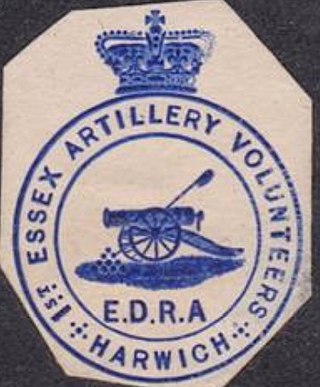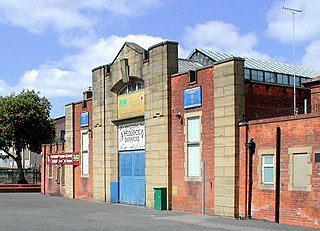The London Regiment was an infantry regiment in the British Army, part of the Territorial Force. The regiment saw service in the First World War and was disbanded in 1938, shortly before the Second World War, when most of its battalions were converted to other roles or transferred elsewhere, and reformed in 1993. The London Guards date their formation to that of this regiment in 1908.
101 (Northumbrian) Medium Regiment Royal Artillery is part of the Army Reserve and has sub units throughout the north east as well as one sub unit in Leeds, West Yorkshire. It is equipped with M270 Multiple Launch Rocket System (MLRS).

The Northumberland Hussars was a Yeomanry regiment of the British Army, transferred to the Royal Artillery for the duration of the Second World War. It was disbanded as an independent Territorial Army unit in 1967, a time when the strength of the Territorial Army was greatly reduced. The regiment's name lives on in the title of the command and support squadron of the Queen's Own Yeomanry (QOY), a Formation Reconnaissance Regiment based in Newcastle upon Tyne.

The South Nottinghamshire Hussars is a unit of the British Army formed as volunteer cavalry in 1794. Converted to artillery in 1922, it presently forms part of 103 Regiment, Royal Artillery.
205 Battery Royal Artillery is part of the 101st (Northumbrian) Regiment Royal Artillery and is equipped with the M270 Multiple Launch Rocket System. It is based in South Shields, United Kingdom.
The Northumberland Brigade was formed in 1908 as part of the Territorial Force of the British Army with four battalions of the Northumberland Fusiliers. The brigade was numbered as 149th (Northumberland) Brigade in 1915 and served with the 50th (Northumbrian) Division on the Western Front throughout World War I. Due to losses suffered in the Ludendorf Offensive in 1918, it had to be comprehensively reorganized. Reformed as the Northumberland Brigade post-war, it was broken up before the outbreak of World War II.
The 63rd Division of the British Army was a second-line Territorial Force division, formed in 1914, which served on home defence duties during the First World War. The division was formed as a duplicate of the 50th (Northumbrian) Division in 1914, composed primarily of soldiers recruited in north-eastern England. It remained on home defence and training duties in the north-east and east of England until 1916, when it was disbanded. Several of its constituent units would later serve overseas, deployed for support and garrison duties in almost every theatre of the war.
The Tynemouth Volunteer Artillery claims to be the oldest volunteer artillery unit of the British Army. It served coastal and siege guns in World War I and World War II, and also served in the infantry role.

The 2nd (Seaham) Durham Artillery Volunteer Corps was a part-time unit of Britain's Royal Artillery raised in County Durham by the Vane-Tempest family during an invasion crisis in 1860. It became a permanent part of the Volunteer Force and later the Territorial Force, and fought as field artillery on the Western Front in World War I. Before World War II it became an anti-aircraft unit that served in the Battle of Britain, the Blitz and in the Far East where it converted to medium artillery in the Burma Campaign. Postwar, it continued to serve in the air defence role in the Territorial Army until 1955.
The 1st Newcastle Engineer Volunteers, later Northumbrian Divisional Engineers, was a Royal Engineer (RE) unit of Britain's Volunteer Force and Territorial Army founded in 1860. Its companies saw action in both World Wars, particularly at the Battle of Rosières and the assault crossing of the River Selle in 1918, and on D-Day in 1944. Its successors continue to serve in today's Army Reserve.
The Northern Cyclist Battalion was a bicycle infantry battalion of the Territorial Force, part of the British Army. Formed in 1908, it served in the United Kingdom throughout the First World War and in 1920 it was converted as part of the Royal Garrison Artillery.
The Militia and Volunteers of Northumberland are those military units raised in the county independently of the regular Army. The "modern" militia dates from legislation enacted during the Seven Years' War. The volunteers had several forms and separate periods of existence until made a permanent body in 1859.

The 1st Essex Artillery Volunteers was a unit of Britain's part-time auxiliary forces raised in Essex in 1860 in response to an invasion scare. It served under various designations as field artillery in Palestine during World War I. During World War II its units served as mountain artillery in Italy and as jungle artillery and medium artillery in Burma. Postwar it became an airborne unit until it was merged with other units in the 1950s.

The Hutton Terrace drill hall is a former military installation in Jesmond, Newcastle upon Tyne.
The 1st North Riding Artillery Volunteers was a part-time unit formed in the North Riding of Yorkshire in 1860 in response to an invasion scare. The unit later became part of the Territorial Force and served on the Western Front during World War I, while their successors served as anti-aircraft gunners in World War II.
The 2nd East Riding Artillery Volunteers was a part-time unit of Britain's Royal Artillery based at Hull and along the Humber Estuary. Its successor units provided field artillery on the Western Front during World War I and air defence artillery during and after World War II. Latterly it formed part of the Humber Artillery based at Hull.

The West Riding Heavy Battery, Royal Garrison Artillery was a part-time unit of Britain's Territorial Force formed in 1908 in the West Riding of Yorkshire. It fought on the Western Front during World War I, and served on in the Territorial Army until the eve of World War II.

Wenlock Barracks is a military installation on Anlaby Road in Kingston upon Hull, England.

50 (Northumbrian) Signal Regiment was a Territorial Army (TA) unit of the British Army's Royal Corps of Signals. It had its origins in a signal company and a cyclist battalion formed in 1908 and it provided the divisional signals for the 50th (Northumbrian) Division and its duplicates during World War II. Its successors continued in the postwar TA until 2009.

The 2nd Northumberland Rifle Volunteer Corps, also referred to as the Tynemouth Rifles, was an infantry unit of Britain's part-time force, the Territorial Army. The corps was raised during the expansion of the Volunteer movement in the 1850s and then served with the Territorial Force during the First World War. It converted to an anti-aircraft role just prior to Second World War, and continued to serve until it was amalgamated in 1950.










